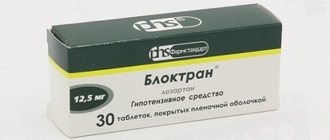Lidocaine ()
The toxicity of lidocaine increases when it is used simultaneously with cimetidine due to an increase in the concentration of lidocaine; this requires a reduction in the dose of lidocaine. Both drugs reduce hepatic blood flow. In addition, cimetidine inhibits microsomal activity. Ranitidine slightly reduces the clearance of lidocaine, which leads to an increase in its concentration. Antiviral agents (eg, amprenavir, atazanavir, darunavir, lopinavir) can also cause increased serum concentrations of lidocaine.
Hypokalemia caused by diuretics may reduce the effect of lidocaine when used simultaneously (see section "Special Instructions").
Lidocaine should be used with caution in patients receiving other local anesthetics or agents structurally similar to amide-type local anesthetics (eg, antiarrhythmic agents such as mexiletine, tocainide) because systemic toxic effects are additive.
Separate drug interaction studies have not been conducted between lidocaine and class III antiarrhythmic agents (eg, amiodarone), but caution is advised.
In patients concomitantly receiving antipsychotics that prolong or may prolong the OT interval (e.g. pimozide, sertindole, olanzapine, quetiapine, zotepine), prenylamine, epinephrine (with occasional intravenous administration) or 5-HT3-serotonin receptor antagonists (e.g. tropisetron, dolasetron ), the risk of developing ventricular arrhythmias may increase.
Concomitant use of quinupristin/dalfopristin may increase lidocaine concentrations and thus increase the risk of ventricular arrhythmias; their simultaneous use should be avoided.
Patients receiving concomitant muscle relaxants (eg, suxamethonium) may have an increased risk of enhanced and prolonged neuromuscular blockade.
Cardiovascular insufficiency has been reported following the use of bupivacaine in patients receiving verapamil and timolol; lidocaine is similar in structure to bupivacaine.
Dopamine and 5-hydroxytryptamine lower the seizure threshold to lidocaine. Opioids appear to have anticonvulsant effects, supported by evidence that lidocaine lowers the seizure threshold to fentanyl in humans. Combinations of opioids and antiemetics, sometimes used for sedation in children, may lower the seizure threshold to lidocaine and increase its CNS depressant effects.
The use of epinephrine with lidocaine may reduce systemic absorption, but with accidental intravenous administration the risk of ventricular tachycardia and ventricular fibrillation increases sharply.
The simultaneous use of other antiarrhythmics, β-blockers and blockers of “slow” calcium channels may further reduce AV conduction, ventricular conduction and contractility.
The simultaneous use of vasoconstrictors increases the duration of action of lidocaine.
Concomitant use of lidocaine and ergot alkaloids (eg, ergotamine) can cause severe hypotension.
Caution must be exercised when using sedatives as they may interfere with the action of local anesthetics on the central nervous system.
Caution should be exercised with long-term use of antiepileptic drugs (phenytoin), barbiturates and other inhibitors of liver microsomal enzymes, as this may lead to decreased effectiveness and, as a result, an increased need for lidocaine. On the other hand, intravenous administration of phenytoin may enhance the inhibitory effect of lidocaine on the heart.
The analgesic effect of local anesthetics can be enhanced by opioids and clonidine.
Ethyl alcohol, especially with prolonged abuse, can reduce the effect of local anesthetics.
Lidocaine is not compatible with amphotericin B, methohexitone and nitroglycerin.
With the simultaneous use of lidocaine with narcotic analgesics, an additive effect develops, which is used during epidural anesthesia, but increases the depression of the central nervous system and respiration. Vasoconstrictors (epinephrine, methoxamine, phenylephrine) prolong the local anesthetic effect of lidocaine and can cause increased blood pressure and tachycardia.
Use with monoamine oxidase inhibitors (furazolidone, procarbazine, seleginine) probably enhances the local anesthetic effect of lidocaine and increases the risk of lowering blood pressure.
Guanadrel, guanethidine, mecamylamine, trimethaphan camsylate increase the risk of a pronounced decrease in blood pressure and bradycardia.
Anticoagulants (including ardeparin sodium, dalteparin sodium, danaparoid sodium, enoxaparin sodium, heparin, warfarin, etc.) increase the risk of bleeding. Lidocaine reduces the cardiotonic effect of digitoxin.
Lidocaine reduces the effect of antimyasthenic drugs, enhances and prolongs the effect of muscle relaxants.
When treating the injection site with disinfectant solutions containing heavy metals, the risk of a local reaction in the form of painful swelling increases.
Mixing lidocaine with other medications is not recommended.
Lidocaine
Drug interactions
When used simultaneously with barbiturates (including phenobarbital), it is possible to increase the metabolism of lidocaine in the liver, reduce the concentration in the blood plasma and, as a result, reduce its therapeutic effectiveness.
When used simultaneously with beta-blockers (including propranolol, nadolol), the effects of lidocaine (including toxic ones) may be enhanced, apparently due to a slowdown in its metabolism in the liver.
When used simultaneously with MAO inhibitors, the local anesthetic effect of lidocaine may be enhanced.
When used simultaneously with drugs that block neuromuscular transmission (including suxamethonium chloride), the effect of drugs that block neuromuscular transmission may be enhanced.
When used simultaneously with hypnotics and sedatives, the inhibitory effect on the central nervous system may be enhanced; with ajmaline, quinidine - possible increased cardiodepressive effect; with amiodarone - cases of seizures and SSSS have been described.
When used simultaneously with hexenal, sodium thiopental (iv), respiratory depression is possible.
When used simultaneously with mexiletine, the toxicity of lidocaine increases; with midazolam - a moderate decrease in the concentration of lidocaine in the blood plasma; with morphine - enhances the analgesic effect of morphine.
When used simultaneously with prenylamine, there is a risk of developing ventricular arrhythmias.
Cases of agitation and hallucinations have been described when used simultaneously with procainamide.
When used simultaneously with propafenone, the duration and severity of side effects from the central nervous system may increase.
It is believed that under the influence of rifampicin, a decrease in the concentration of lidocaine in the blood plasma is possible.
With simultaneous intravenous infusion of lidocaine and phenytoin, side effects of central origin may increase; a case of sinoatrial block due to the additive cardiodepressive effect of lidocaine and phenytoin is described.
In patients receiving phenytoin as an anticonvulsant, a decrease in the concentration of lidocaine in the blood plasma is possible, which is due to the induction of microsomal liver enzymes under the influence of phenytoin.
When used simultaneously with cimetidine, the clearance of lidocaine moderately decreases and its concentration in the blood plasma increases, and there is a risk of increased side effects of lidocaine.
Release forms
For medical use, lidocaine comes in a wide range.
| Dosage form | Active substance | Lidocaine hydrochloride concentration |
| 1% solution for injection | Lidocaine hydrochloride | 10 mg per 1 ml. |
| 2% solution for injection | 20 mg per 1 ml. | |
| 10% solution for injection | 100 mg per 1 ml. | |
| Eye drops 2% | 20 mg per 1 ml. | |
| Eye drops 4% | 40 mg per 1 ml. | |
| Topical spray 10% | 4.6 mg per 1 dose | |
| Topical gel 5% | 50 mg per 1 g. | |
| Ointment for topical use 5% | 50 mg per 1 g. | |
| Cream for external use | 2.5 g per 100 g. | |
| Plaster for external use (Versatis, Emla). | 700 mg per 1 patch | |
| Ear drops (Anauran, Candibiotic, Lorotox, Otipax). | Combined composition | 4 g per 100 ml; |
| Rectal and vaginal suppositories (Gepazolone, Neo-Penotran Forte L, Proctosan, Relief Pro). | Combined composition | From 20 mg to 100 mg per 1 piece. |
| Lozenges (Gexoral tabs extra, Septalor, Sirepsils Express). | Combined composition | 5–10 mg per 1 tablet. |
| Suspension for injection (Hydrocortisone-Richter, Hydrocortisone + Lidocaine Binergia). | Combined composition | 5 mg per 1 ml. |
Lidocaine
Mixing lidocaine with other medications is not recommended.
The toxicity of lidocaine increases when co-administered with cimetidine, which requires a reduction in the dose of lidocaine. Both drugs reduce hepatic blood flow. In addition, cimetidine inhibits the microsomal activity of liver enzymes. When lidocaine is administered intravenously to patients taking cimetidine, undesirable effects such as a state of stupor, drowsiness, bradycardia, paresthesia, etc. are possible. This is due to an increase in the concentration of lidocaine in the blood plasma, which is explained by the release of lidocaine from binding with blood proteins, as well as its slowdown inactivation in the liver.
Ranitidine, diltiazem, verapamil, propranolol and other β-blockers reduce the clearance of lidocaine and may lead to an increase in its concentration in the blood.
Antiretroviral drugs (for example, amprenavir, atazanavir, darunavir, lopinavir) can also cause an increase in lidocaine plasma concentrations.
Hypokalemia caused by diuretics may reduce the effect of lidocaine when used simultaneously (see section "Special Instructions").
Lidocaine should be used with caution in patients receiving drugs structurally similar to amide-type local anesthetics (eg, antiarrhythmic drugs such as mexiletine, tocainide) due to the possibility of potentiation of systemic toxic effects.
Separate drug interaction studies have not been conducted between lidocaine and class III antiarrhythmic drugs (eg, amiodarone), but caution is recommended when using them together.
In patients concomitantly receiving antipsychotics that prolong or have the potential to prolong the QT interval (e.g., pimozide, sertindole, olanzapine, quetiapine, zotepine), prenylamine, epinephrine (with occasional intravenous administration), or 5-HT3-serotonin receptor antagonists (e.g., tropisetron, dolasetron), the risk of developing ventricular arrhythmias may increase.
Concomitant use of quinupristin/dalfopristin may increase lidocaine concentrations and thus increase the risk of developing ventricular arrhythmias; their simultaneous use should be avoided.
Concomitant use of other antiarrhythmic drugs, beta-blockers, and slow calcium channel blockers may further reduce AV conduction, ventricular conduction, and myocardial contractility.
Lidocaine enhances and prolongs the effect of muscle relaxants; In patients receiving muscle relaxants (eg, suxamethonium), the risk of increased and prolonged neuromuscular blockade may be increased.
Cardiovascular insufficiency has been reported following the use of bupivacaine in patients receiving verapamil and timolol; lidocaine is similar in structure to bupivacaine.
With the combined use of lidocaine and dopamine, 5-hydroxytryptamine, as well as opioid narcotic analgesics (fentanyl), the seizure threshold is reduced. Combinations of opioids and antiemetics, sometimes used for sedation in children, may lower the seizure threshold and increase the CNS depressant effects of lidocaine.
The simultaneous use of vasoconstrictors increases the duration of action of lidocaine.
Concomitant use of lidocaine and ergot alkaloids (eg, ergotamine) can cause severe hypotension.
Caution must be exercised with long-term use of antiepileptic drugs (phenytoin), barbiturates and other inhibitors of liver microsomal enzymes, as this may lead to decreased effectiveness and, as a result, an increased need for lidocaine. On the other hand, intravenous administration of phenytoin may enhance the depressant effect of lidocaine on the heart.
The combined use of lidocaine with procainamide can cause central nervous system stimulation and hallucinations.
Aymaline, amiodarone, verapamil and quinidine enhance the negative inotropic effect of lidocaine.
Patients taking monoamine oxidase inhibitors (furazolidone, procarbazine, seleginine) should not be prescribed parenteral lidocaine.
When using lidocaine and polymyxin-B simultaneously, it is necessary to monitor the patient's respiratory function.
When lidocaine is used in combination with hypnotics and sedatives, narcotic analgesics, hexenal or sodium thiopental, the inhibitory effect on the central nervous system and respiration may be enhanced.
Lidocaine reduces the cardiotonic effect of digitoxin\ reduces the effect of antimyasthenic drugs (prozerin, oxazil, etc.). When used together with heparin, NSAIDs or plasma expanders, it increases the tendency to bleeding. Ethyl alcohol, especially with prolonged abuse, can reduce the effect of lidocaine.
Lidocaine is incompatible with amphotericin B, methohexitone and nitroglycerin.







